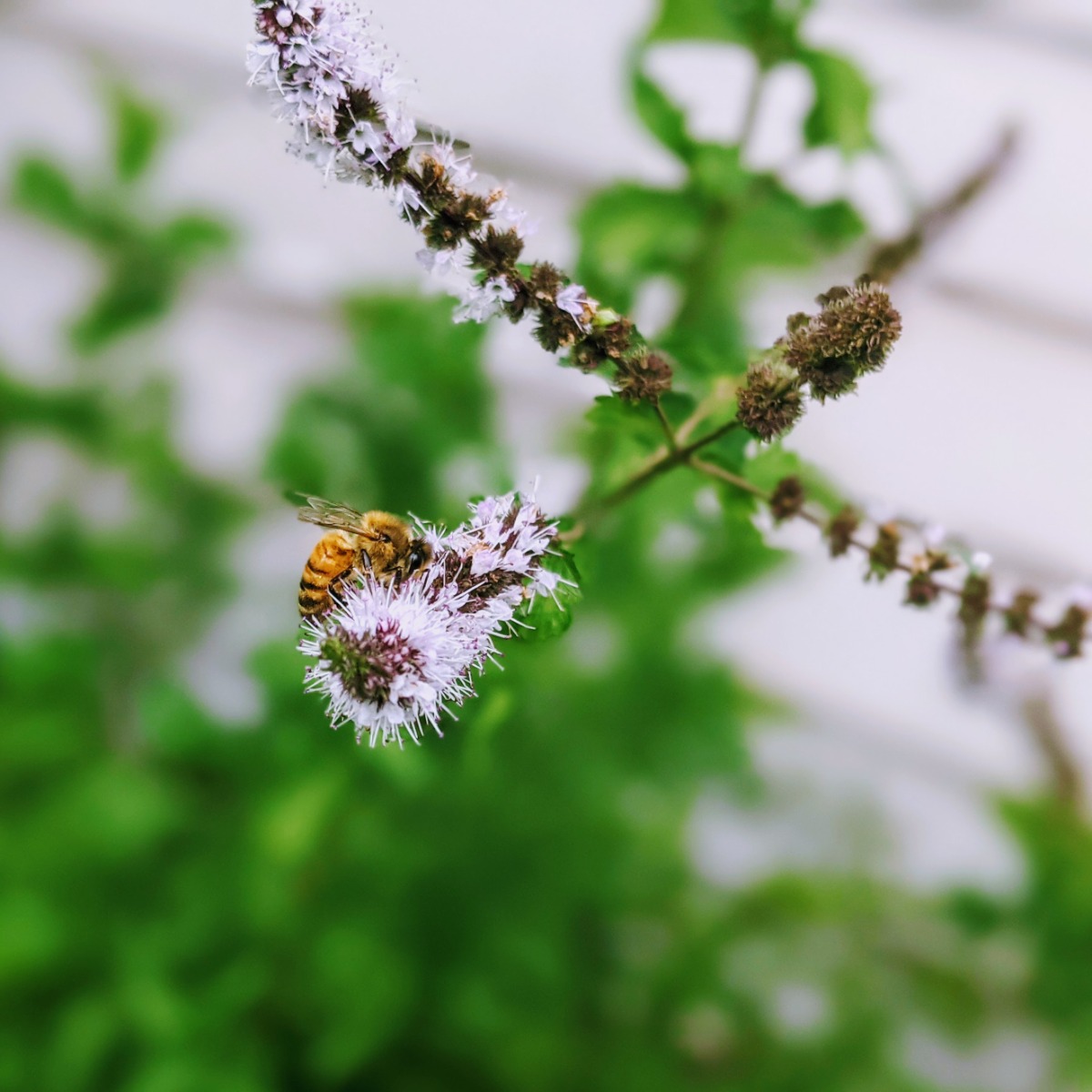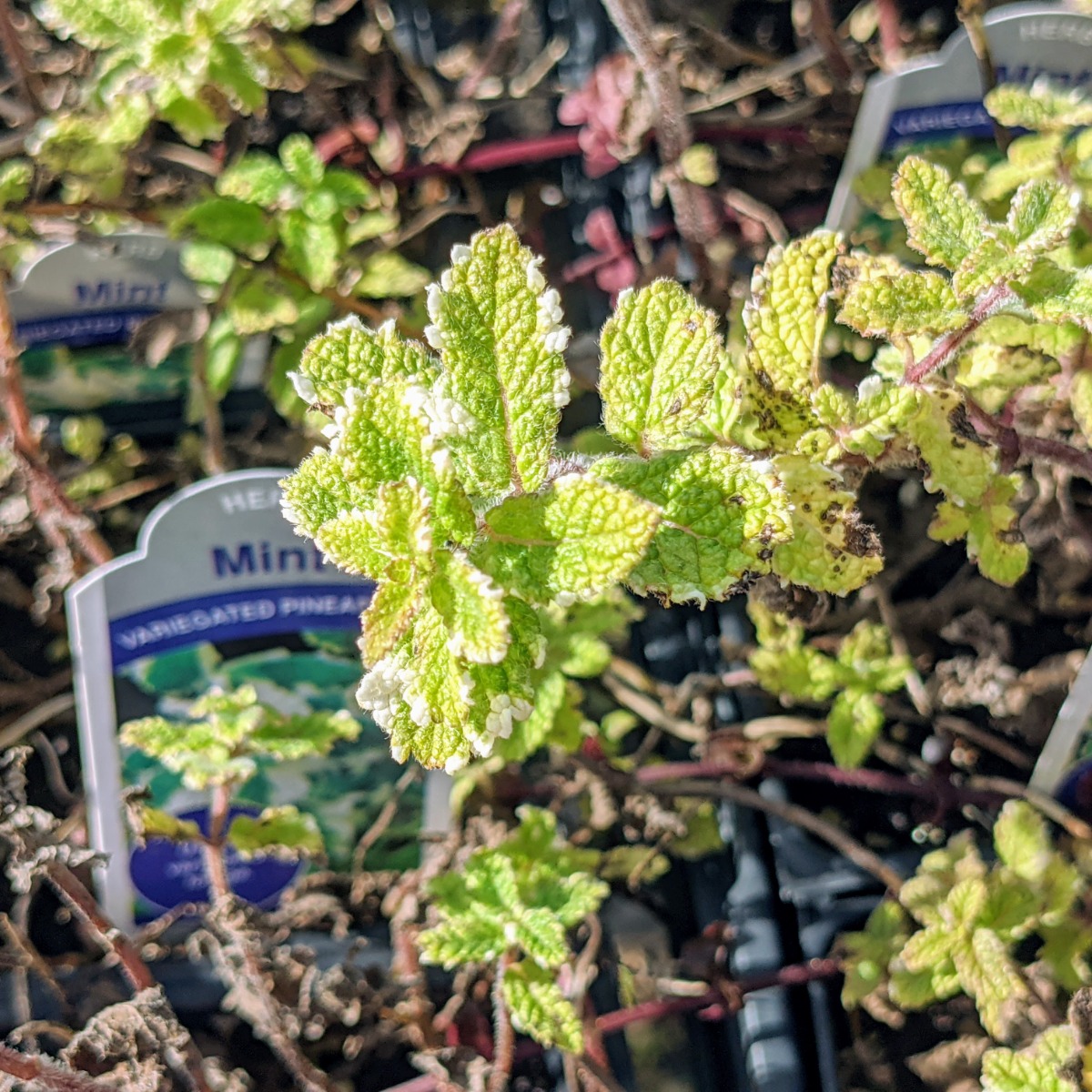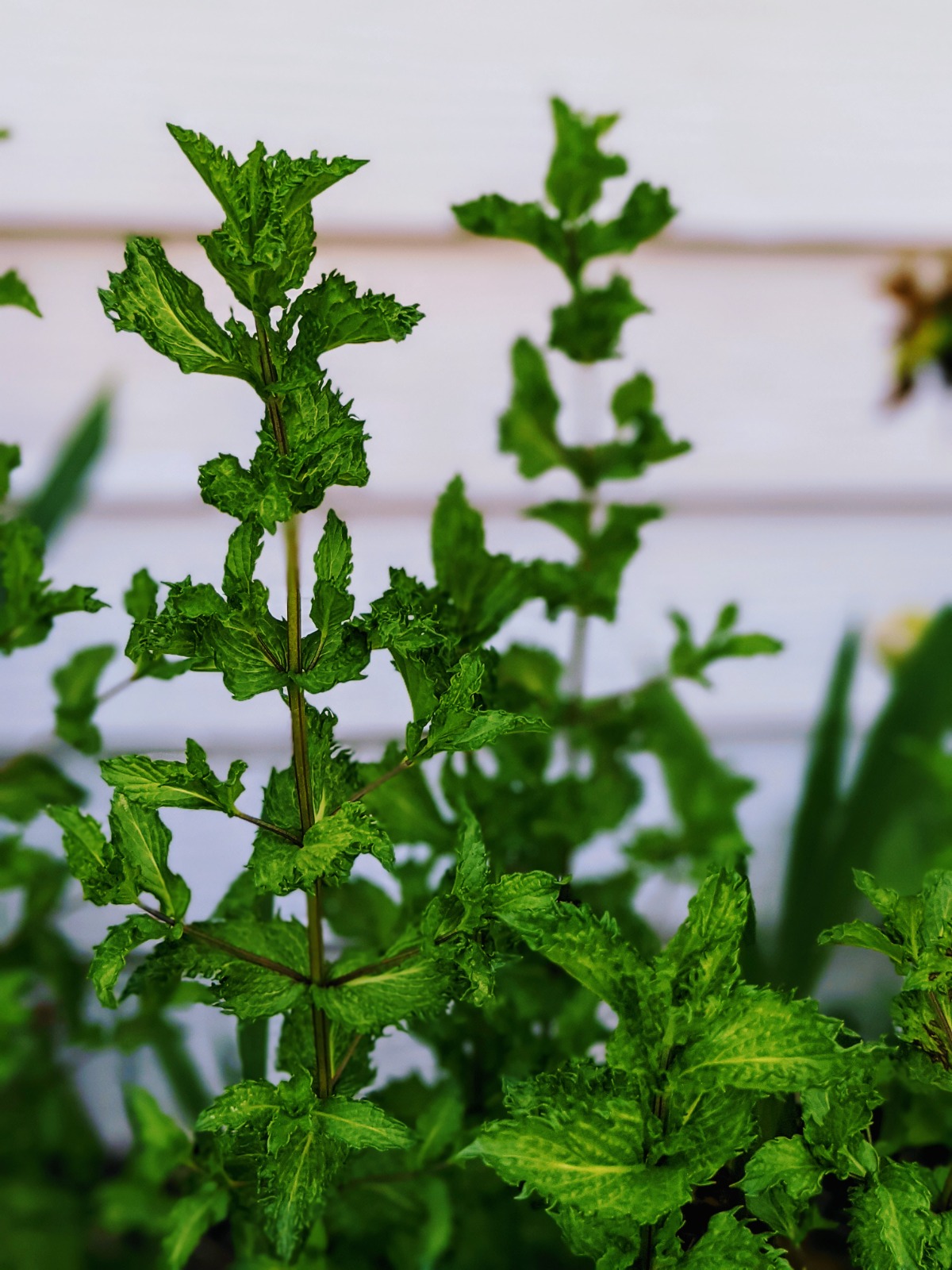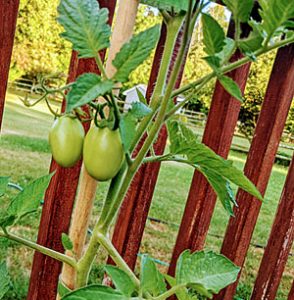Mint Companion Plants – Evil Mint Has Some Redeeming Qualities
Mint sometimes gets a bad rap in the garden. Finding mint companion plants can be a good way to make the most of this versatile herb. (A much better way than growing mint willy-nilly in the yard like I did. *facepalm*)
I’ll never make THAT mistake again.

When we first moved to our home, I planted a few sprigs of peppermint from my mom’s garden. Not knowing how invasive mint can be, I thought nothing of it. But the mint literally took over the whole flowerbed. I am STILL dealing with it to this day.
Effing mint. (:
Anyway, instead of being mad at a plant that just wants to win all the time, I’ll play along. (I mean, how can you be mad at a plant with #goals right?!)
I’ve fallen in love with the smell of spearmint and the idea of chocolate mint, pineapple mint, and others.
So, I’ve discovered some benefits of companion planting with mint and look forward to sharing them with you below!

(Of course, keep in mind your mileage may vary. Some companion planting claims may be purely anecdotal from one gardener to the next – feel free to share your own experiences in our comments below!)
Why is mint a bad companion plant?
If not contained, mint becomes invasive. Left to its own devices, mint grows quickly and can swiftly take over an entire garden bed. Mint’s root systems can grow densely, choking out other plants in the process.
Some gardeners say mint actually attracts the very pest insects you want it to deter. Mint pests often include aphids, cutworms, flea beetles, and spider mites. (Source)
(Take note that some mint companion planting guides out there advise otherwise. It is tough to dig up exact and proven advice. Numerous sources I dug up in my research actually tout mint as a repellent for these very pests!)
Mint doesn’t have to be a poor companion plant, though. Simply grow mint in containers and look for plant companions for mint where you can set the pots nearby.
Why is mint a good companion plant?
Mint has a fresh and minty aroma that some garden pests can’t stand. This includes both wildlife and insect pests. Mint can deter carrot root fly and onion flies, among others. When blooming, mint’s flowers can help to attract pollinators.

What are some good mint companion plants?
Despite mint’s inclination to take over, you can interplant other vegetables, flowers, and herbs with mint. Some good companion plants for mint include: brassicas, carrots, lettuce, tomatoes, squash, oregano, and marigolds, to name a few.
You can find numerous other options for mint plant companions in the garden.
What can you not plant with mint?
Avoid planting lavender, rosemary, sage, oregano, and thyme near mint. Some other bad mint companions include basil, chamomile, and parsley, along with most common herbs. Also, because mint can be invasive, you should not plant mint directly in the ground unless it’s free to roam.
The Best Companion Plants for Mint
Choose the best planting companions for mint to make the best use of your gardening space.
Here are some good companions for your favorite varieties of mint:

Brassicas
Grow brassicas with mint for more of a fighting chance. Allegedly, mint can help to repel the cabbage white moth – a common pest for brassicas. (Source)
Our brassicas always get decimated by the cabbage white butterfly (moth) so I’d love to try companion planting with mint to help defeat this awful pest. (Although, I’m pretty sure we’ll still need insect netting barriers.)
Consider planting mint with:
- Broccoli
- Brussels Sprouts
- Cabbage
- Cauliflower
- Kale
- Kohlrabi
Legumes
Protect your legumes (beans and peas especially) from rodents in the garden. The minty aroma may deter field mice, moles, and voles from stealing your harvest.
- Beans (bush beans and pole beans)
- Peas / Snow Peas
Nightshades
Mint grows well with nightshades, including eggplant, peppers, potatoes, and tomatoes.
Anecdotal evidence suggests mint helps to repel aphids, flea beetles, and spider mites, but information from various cooperative extensions say otherwise. ymmv
- Eggplant – Anecdotal evidence
- Peppers – Anecdotal evidence
- Potatoes – The presence of mint can help to fend off ants, mice, and other rodents near your potato patch. (Source)
- Tomatoes –Companion planting with mint and tomatoes may enhance flavor and improve the health of your plants.
Root Vegetables
Try growing root veggies as a companion plant nearby a container of mint.
- Beets – The rich aroma of mint boldly deters quite a few garden pests that may otherwise feast on your beets.
- Carrots – Mint repels the carrot root fly, giving your carrot crops a better chance.
- Onions – Planted nearby onions, mint can help deter onion fly.
- Radishes – Some believe mint improves the flavor of radishes grown nearby. Pests also tend not to like mint.

Other Plant Companions for Mint
Despite its ability to swiftly take over a garden, mint continues to offer benefits in the garden.
Consider companion planting mint with flowers, vegetables, and herbs. You can plant mint in containers and relocate them as needed to derive the best benefits in the garden.
More Vegetable & Mint Companion Plants
Most common herbs don’t do well planted together with mint. Mint often prefers a moist soil where many herbs like soil on the dry side.
Consider these veggies and herbs when companion planting with mint:
- Lettuce – Since lettuce appreciates the shade, you may find taller mint to be a suitable companion.
- Squash – Anecdotal evidence suggests the scent of mint helps to deter some bad squash pests in the garden.

Companion Flowers for Mint
Growing flowers with mint nearby can be another creative gardening combination!
- Marigolds – Also known for their own benefits in the garden, marigolds can grow in the same environment as mint. (Still, keep in mind mint’s diehard mission to spread, spread, spread!)
- Roses – Anecdotal evidence only
Other flowers that grow well with mint likely also prefer a moist growing environment. Still, some very forgiving flowers may also be a great flower companion for mint. I’ve grown sunflowers and zinnias in the same garden bed as mint.
Also, my peonies are so established in that flower bed that they’ve seen no competition for space despite mint’s spreading all around them.

Companion Planting with Mint – Most Important Tip
When choosing planting companions for mint, the most important thing to remember is that mint can be invasive.
You should really keep mint contained in its own space. Whether that is a specific garden bed or a container is up to you. Even in a container, be extra vigilant. Mint’s roots are vigorous!
As a bonus tip, consider using some of your homegrown mint in fresh cocktails, as garnishes, or even in your fresh-cut flower arrangements!
Our website features affiliate links to products that we personally believe in. If you make a purchase from a link on our site, we may earn a small commission at no cost to you. Thank you! This helps our girls chase their garden dreams! Thanks for your support. (View full affiliate disclaimer at the end of the page.)
Are you growing mint in your backyard garden? Feel free to share any tips or questions about plant companions for mint in our comments below. We love hearing from you!
Happy Gardening!
10.03.22 – Updated to add a new photo and plant selections.







I’m not sure if you noticed but oregano is listed in both “What not to plant with mint?” and “What are some good mint companion plants?” Is there a nuance that I’m missing?
Hi Nik, thanks for calling this to my attention! I did not realize this conflicting info, as I probably wrote this post in the wee hours after my kids were in bed. 🙂 I would avoid planting oregano and mint together, mainly because oregano prefers a less-watered environment and mint can rapidly take over a space. That being said, they’d likely do great in pots nearby each other or planted far enough apart to water each independently. I will update the post – thanks again! Best of luck with your garden!
I have a side yard in the back and want to let the mint grow back there and I can just mow it down when it gets a little wild. I don’t need other plants near it but hoping it will naturally deter mosquitos and smell nice, and I don’t want to put in grass necessarily. Do you think it could fight off the crab grass if that tries to sneak in from my front yard? Are there any holes in my plan? I already have the mint ready to go, grown in my containers.
Hi Becca! Nice to hear from you! I think your plans for mint sound pretty solid! Since you don’t mind it spreading, it should take over nicely, and mint smells great when mowed!
As for the crabgrass, I do think the mint will grow densely enough to largely take over. You may want to pull some of the bigger ones when planting but once mint is established, the only major plant we had disrupting the bed ended up being thistles and occasional dandelions. (Our hosta and peonies and butterfly bush do come back each year, but our lilies got choked out.)
Good luck and let us know if you need anything, or feel free to update!
Hi, I have lots of wasps where I live and have been trying to find a more natural deterrent. If I let it run wild in my grass would that help? I have to keep my grass mowed (city ordinance) so I’m not worried about it getting too crazy. Also, I live where it snows in the winter, would it be able to survive the winter? Thanks in advance!
Hi Alex! So sorry for the delay – I hope I can still help. Ugh, sorry to hear about the wasps. You can certainly try the mint. We don’t have much of a problem with them and the mint runs wild behind my garage. It does creep into the grass and smells amazing when we mow! I am in Pennsylvania and the mint not only survives the winter but comes back stronger every year. We specifically grow peppermint and I believe peppermint oil is an ingredient in natural wasp repellent so I say go for it! I’ve seen some say that basil, thyme, lemongrass, and some other strong-scented herbs will also deter. Best of luck!